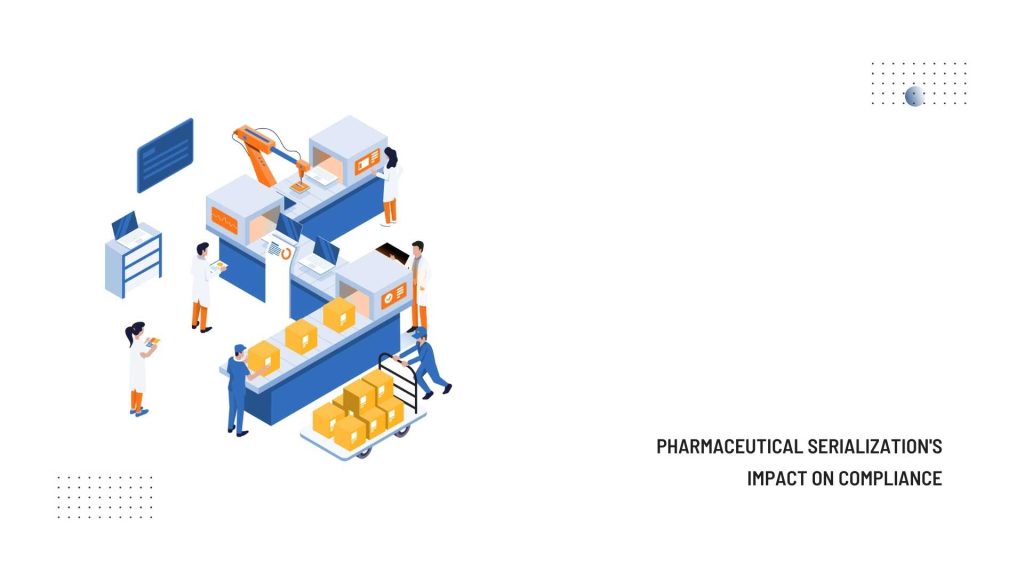Ensuring pharmaceutical product safety is crucial for patient well-being in the life sciences industry. Compliance with regulations is a moral obligation. Pharmaceutical serialization is a transformative tool for compliance and traceability in the supply chain.
Pharmaceutical serialization involves assigning a distinct serial number to each saleable drug product unit, which is then stored in a central database along with other relevant information. This process ensures end-to-end traceability, allowing for the tracking and verifying of every pharmaceutical product at every stage of the supply chain. Here are some key points:
Regulatory Compliance:
Regulatory bodies worldwide often mandate serialization to combat issues like counterfeit drugs, ensure patient safety, and enhance supply chain transparency. Regulations such as the Drug Supply Chain Security Act (DSCSA) in the United States and the Falsified Medicines Directive (FMD) in Europe require pharmaceutical companies to implement serialization.
Traceability:
Serialization enables precise tracking and tracing of pharmaceutical products throughout the supply chain. This traceability is crucial for ensuring that drugs are authentic, not counterfeit, and handled appropriately from manufacturing to distribution to dispensing.
Product Authentication:
Serialization allows for product authentication at various points in the supply chain. Pharmacists, wholesalers, and other stakeholders can verify the authenticity of drug products by scanning the unique serial numbers encoded on the packaging. This authentication process helps identify and prevent the distribution of counterfeit or adulterated drugs.
Quality Control:
Serialization facilitates better quality control by enabling manufacturers to monitor the movement of individual drug units throughout the supply chain.
This visibility helps recall and address issues such as product recalls, expired products, or instances of diversion.
Data Management:
Serialization generates vast amounts of data regarding the movement and status of pharmaceutical products. Compliance requires pharmaceutical companies to manage this data efficiently, ensuring its accuracy, integrity, and security.
Data management systems must meet regulatory requirements for data storage and access control.
Training and Education:
Compliance with serialization regulations necessitates training employees across various functions on serialization processes, procedures, and regulatory requirements.
It includes training on handling serialized products, scanning serial numbers, and responding to serialization-related issues such as product recalls or suspect products.
Leverage ERP for Pharmaceutical Serialization
Here’s why harnessing ERP for pharmaceutical serialization is a game-changer:
End-to-End Traceability:
Integrating serialization capabilities into your ERP enables seamless tracking of pharmaceutical products from manufacturing to distribution and beyond.
This end-to-end traceability enhances visibility into the supply chain, empowering swift response to product recalls or counterfeiting issues.
Regulatory Compliance:
Compliance with stringent regulations such as the US Drug Supply Chain Security Act(DSCSA) or the EU’s Falsified Medicines Directive(FMD) is non-negotiable.
You can automate compliance processes, streamline reporting, and ensure adherence to regulatory mandates without manual intervention by harnessing your ERP for serialization.
Efficient Operations:
Serialization integration optimizes operational efficiency by automating data capture, reducing manual errors, and streamlining inventory management.
ERP systems equipped with serialization capabilities provide real-time insights that enable proactive decision-making and agile response to supply chain disruptions.
Counterfeit Prevention:
Counterfeit pharmaceuticals significantly threaten public health and brand reputation.
Serialization allows for the authentication of products at every stage of the supply chain, making it harder for counterfeiters to infiltrate and ensuring patients receive genuine medications.
Data Analytics and Insights:
ERP systems equipped with serialization functionality generate vast amounts of data that can be analyzed to derive actionable insights.
From identifying trends to optimizing inventory levels, leveraging data analytics enhances operational efficiency and drives strategic decision-making.
Conclusion:
Integrating Acumatica ERP into the pharmaceutical sector is a significant milestone in improving traceability. Acumatica’s powerful ERP system simplifies operations by bringing together data from multiple sources, offering immediate visibility into the supply chain.
This incorporation guarantees adherence to traceability regulations, fostering a culture of safety and transparency. Furthermore, the ERP’s functionalities facilitate the seamless incorporation of traceability technologies like serialization, track and trace, and verification mechanisms, enabling pharmaceutical firms to maintain regulatory compliance with precision.

Vijay comes with a vast experience in ERP and enterprise solutions space with about 20 years of experience in various packaged application like Acumatica, SAP, Orion, Salesforce.com, SugarCRM and, SalesLogix.

